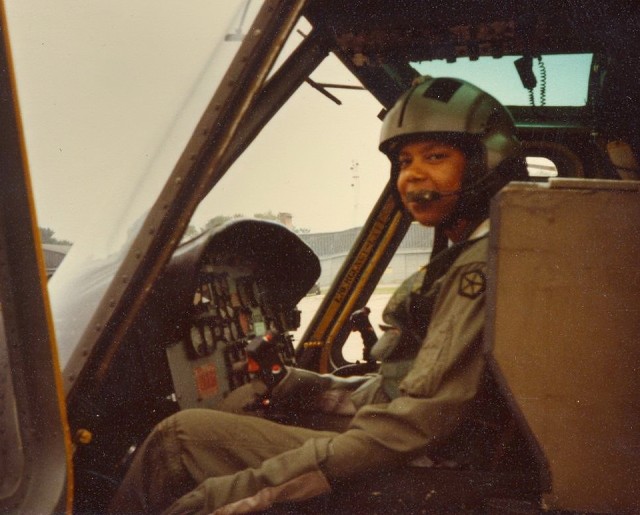WASHINGTON (Army News Service, Aug. 1, 2008) - Back in 1980 Christine B. "Nickey" Knighton became just the second black woman in the United States to earn the right to wear aviator wings within the Department of Defense and the first from her home state of Georgia, an accomplishment that didn't go unnoticed by then-President Jimmy Carter who personally congratulated her on the achievement.
Col. Knighton also holds the distinction of commanding a tactical combat arms unit, specifically, 2nd Battalion, 227th Aviation Bn., 1st Cavalry Division at Fort Hood, Texas from 1996-1998.
Yesterday, Knighton was the senior black female aviator on active duty within DOD. Today, with more than 29 years Army service, she retires.
Looking back Knighton admits she had no idea she'd wind up in the Army, much less make the service nearly a three-decade career. That all began, when in 1975 while on a student loan, she left her rural small-town to study home economics across the border in Alabama at Tuskegee Institute, today Tuskegee University.
Then the Army just kind of happened.
"I initially joined the Reserve Officer Training Corps out of curiosity and for the additional credits so I signed on because it was a freshman elective," she said. "I spent my first year studying very hard in the library, in the dormitory and the classroom and the result was I got very good grades, so I was encouraged by the ROTC department to apply for a scholarship because they'd never had a woman apply for one, so I did."
Curiosity about the Army turned into necessity because going into her second year of college, funding became an issue. She'd applied for financial assistance through the institute and simultaneously applied for the ROTC scholarship. She recalled receiving the letters on the same day - both approvals for funding, but the ROTC offer was a full scholarship and an opportunity not often open to women.
"So I had a decision to make - do I go home or back to school with an Army obligation'" Knighton added. "It's amazing how things work out. My mother who was a textile worker and a single parent had a big part to do with my decision. She would talk about the Women's Army Corps and I tried to get her to make the choice for me, but she refused because she knew that would be the decision I would have to live with."
Cadet Knighton said she found diversity in the Army from the very beginning of her Tuskegee education; because one of the military science professors insisted on it, Tuskegee's cadre was racially integrated with noncommissioned and commissioned officers.
"I think that helped prepare me for the real Army," she said. "You go to some historically black colleges and universities and the entire cadre is black, but that doesn't really help prepare you for the real world.
"The military professor in charge of preparing the cadets for summer camp was Caucasian and he actually told us what we were going to be up against as students from a black college going into an integrated environment," Knighton added. "He prepared us for orienteering competitions with students from all over the South and other colleges so when we got to summer camp, it wasn't a surprise to see the diversity of people you don't normally see on your college campus every day."
When Knighton went off to Fort Rucker in southern Alabama for flight training, she said she was pretty much accustomed to what life was like outside the fort's gates. Life was more of a challenge being only the second black woman to make it through flight training, part of which she attributed to the fact that women in 1980 weren't allowed to serve in combat arms roles. She was a quartermaster seeking to be a pilot.
"I think I may have used some of the negativity as a motivator to say, 'I'll show you'... that's the way I grew up," she said. "I grew up in a single-parent household, so I already started out at a disadvantage, but my two sisters and I were encouraged to do whatever we felt we wanted to do, to follow our dreams and not allow ourselves to be held back by limitations."
It has been 60 years since integration - hence diversity -- was made possible due to Executive Order 9981, signed by President Harry Truman on July 26, 1948. The order called for equal treatment and opportunity.
"I don't think we can lose sight of where we are and how far we've come and I don't think it's something we can afford to take for granted either," she said. "If we take diversity and integration for granted, one day we'll look around and see an officer corps that's not reflective of its enlisted corps, with women and people of different colors and backgrounds.
"Diversity is very important, especially if you look at the places we are going to be in the future, such as the U.S. Africa Command," Knighton said. "It's important for us as a nation to model for the world what it's like to get along as a people."
Last month, Knighton was presented with the Tuskegee Airmen Gen. Benjamin O. Davis Jr. Military Award for her noteworthy professional achievements throughout her career.
She also holds the Order of Saint Michael for outstanding contributions to Army Aviation. Knighton is founder of a public service non-profit organization active in southwest Georgia. Since 1990, SHAPE - Self-esteem, Harmony, Awareness, Pride and Education has provided undergraduate educational opportunities for high school seniors. She is also a past vice president of the Bessie Coleman Foundation, an organization committed to sponsoring and promoting careers in aviation in the military as well as private and commercial sectors.




Social Sharing